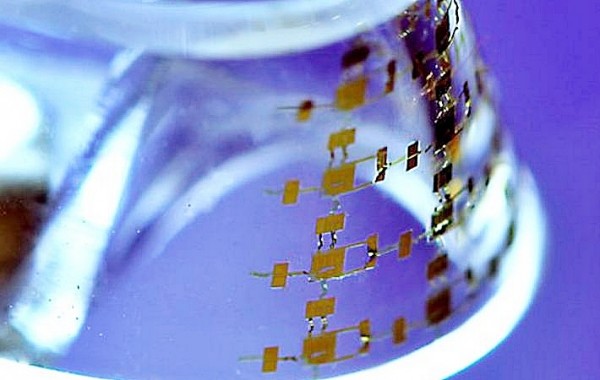3D-Printed 'Bionic Skin' Might Confer Sense of Touch on Robots
| Arthur Dominic Villasanta | | May 13, 2017 11:48 PM EDT |
(Photo : Missouri University of Science and Technology) Another kind of 3D-printed stretchable electronic device.
A revolutionary process for 3D printing stretchable electronic sensory devices that might one day give robots the ability to feel their environment has been developed by engineering researchers at the University of Minnesota.
The discovery is also a major step forward in printing electronics on real human skin.
Like Us on Facebook
"This stretchable electronic fabric we developed has many practical uses," said Michael McAlpine, a University of Minnesota mechanical engineering associate professor and lead researcher on the study.
"Putting this type of 'bionic skin' on surgical robots would give surgeons the ability to actually feel during minimally invasive surgeries, which would make surgery easier instead of just using cameras like they do now. These sensors could also make it easier for other robots to walk and interact with their environment."
McAlpine, who gained international acclaim in 2013 for integrating electronics and novel 3D-printed nanomaterials to create a "bionic ear," said this new discovery could also be used to print electronics on real human skin.
This ultimate wearable technology could eventually be used for health monitoring or by soldiers in the field to detect dangerous chemicals or explosives.
"While we haven't printed on human skin yet, we were able to print on the curved surface of a model hand using our technique," said McAlpine.
"We also interfaced a printed device with the skin and were surprised that the device was so sensitive that it could detect your pulse in real time."
McAlpine and his team made the unique sensing fabric with a one-of-a kind 3D printer they built in the lab.
The multifunctional printer has four nozzles to print the various specialized "inks" that make up the layers of the device -- a base layer of silicone; top and bottom electrodes made of a conducting ink; a coil-shaped pressure sensor and a sacrificial layer that holds the top layer in place while it sets.
Surprisingly, all of the layers of "inks" used in the flexible sensors can set at room temperature. These flexible 3D printed sensors can stretch up to three times their original size.
"This is a completely new way to approach 3D printing of electronics," said McAlpine. "We have a multifunctional printer that can print several layers to make these flexible sensory devices. This could take us into so many directions from health monitoring to energy harvesting to chemical sensing."
Researchers say the best part of the discovery is that the manufacturing is built into the process. The researchers say the next step is to move toward semiconductor inks and printing on a real body.
"The possibilities for the future are endless," said McAlpine.
Tags3D Printing, stretchable electronic sensory devices, Robots, human skin, stretchable electronic fabric, bionic skin, Michael McAlpine, University of Minnesota
©2015 Chinatopix All rights reserved. Do not reproduce without permission
EDITOR'S PICKS
-

Did the Trump administration just announce plans for a trade war with ‘hostile’ China and Russia?
-

US Senate passes Taiwan travel bill slammed by China
-

As Yan Sihong’s family grieves, here are other Chinese students who went missing abroad. Some have never been found
-

Beijing blasts Western critics who ‘smear China’ with the term sharp power
-

China Envoy Seeks to Defuse Tensions With U.S. as a Trade War Brews
-

Singapore's Deputy PM Provides Bitcoin Vote of Confidence Amid China's Blanket Bans
-

China warns investors over risks in overseas virtual currency trading
-

Chinese government most trustworthy: survey
-

Kashima Antlers On Course For Back-To-Back Titles
MOST POPULAR
LATEST NEWS
Zhou Yongkang: China's Former Security Chief Sentenced to Life in Prison

China's former Chief of the Ministry of Public Security, Zhou Yongkang, has been given a life sentence after he was found guilty of abusing his office, bribery and deliberately ... Full Article
TRENDING STORY

China Pork Prices Expected to Stabilize As The Supplies Recover

Elephone P9000 Smartphone is now on Sale on Amazon India

There's a Big Chance Cliffhangers Won't Still Be Resolved When Grey's Anatomy Season 13 Returns

Supreme Court Ruled on Samsung vs Apple Dispute for Patent Infringement

Microsoft Surface Pro 5 Rumors and Release Date: What is the Latest?













